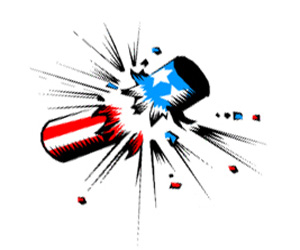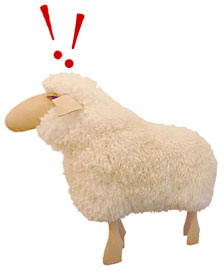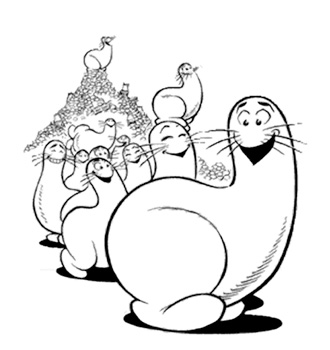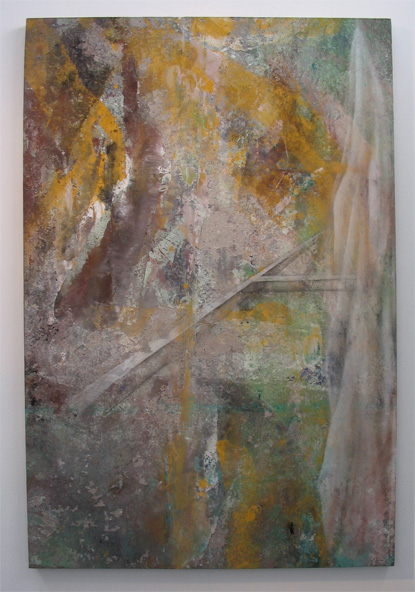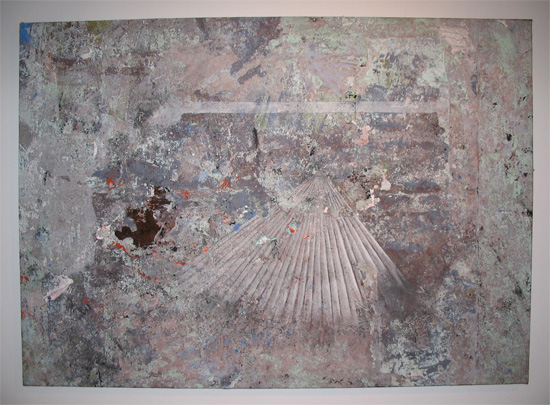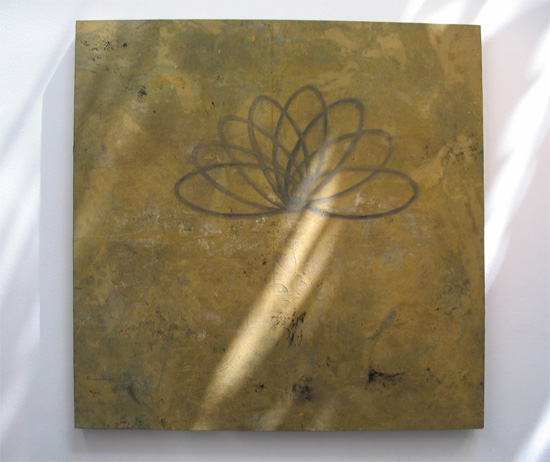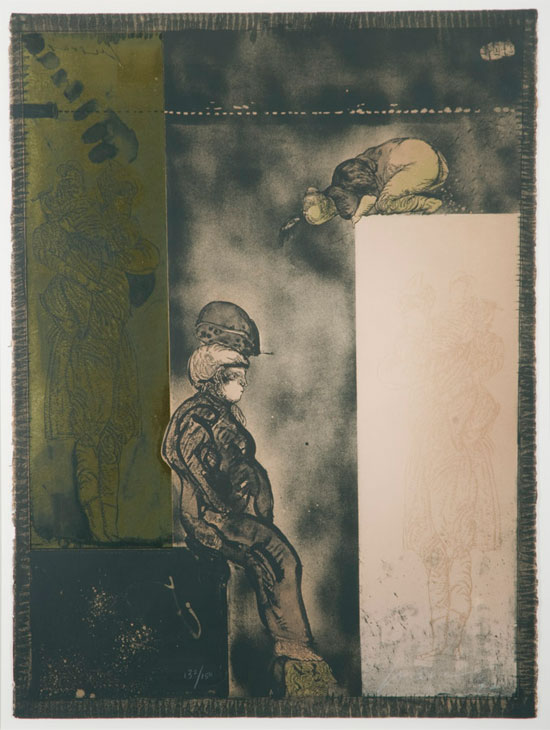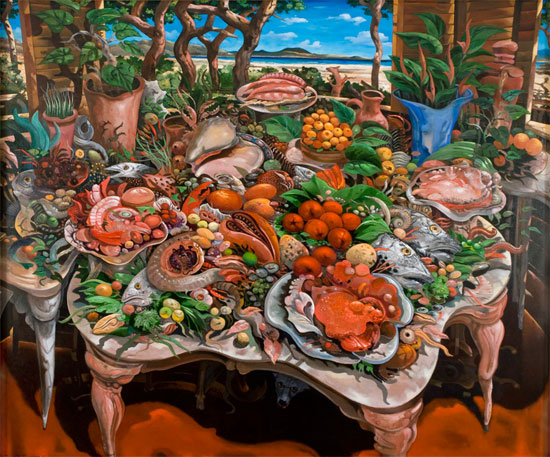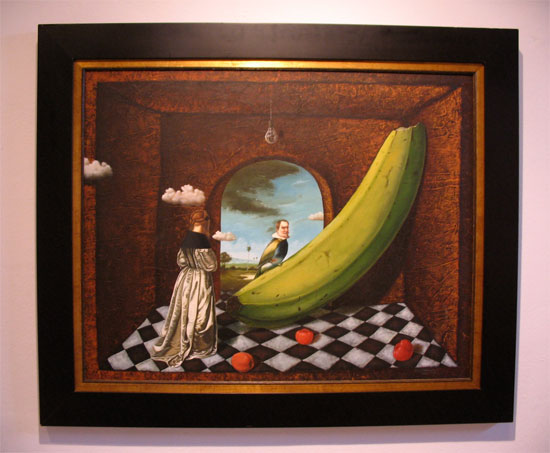|
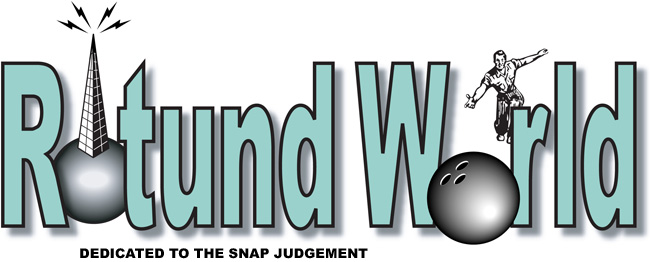
Where Seldom Is Heard
We try to be the live-and-let-live kind, especially when it comes to artworld spats, tantrums, bouts of paranoia, internecine shit-flingings, red-faced, bug-eyed spittle-fests, pissant stampings, hysterical finger-pointing, and other hissy fits, but someone must have really crossed the line to ruffle the always well-preened feathers of Javier Martínez, the astute, carefully understated blog-jockey over at autogiro. Martínez took pronounced umbrage here at the much-discussed move by el Museo de Arte de Puerto Rico (MAPR) to invite a television variety-show bombshell-poseur into its inner sanctum, to sell the museum to the tourist trade. Actually, to say “much-discussed” does not begin to describe the holding of noses, cries of disbelief, and barfing sounds that accompanied the announcement that catástrofe-y-disastre-loving María Celeste Arrarás (“Goat born with two heads in Aibonito!” “Comerío mother of ten crushed by toppling armoire!”) had created a segment on the museum for a program she hosts called “Great Taste,” which will be aired by the Travel Channel one of these days as part of a tour of la Isla del Encanto. What most creeped Martínez out—and seems to have gotten the artworld’s easily inflamed hoi polloi more lathered up than usual—was how the museum hierarchy fell all over itself to wrap Puerto Rican culture in falsehood and extreme cheesiness. The museum, after all, approached The Vapid One, whose concerns are, shall we say, enormously self-absorbed and slightly less than skin-deep.
“For me,” she told one of the island’s pitiful excuses for a daily newspaper, “the most important thing of all [in doing the segment] was to present myself as well-dressed and elegant . . . I wanted to be seen as serious but not like a nun, wearing a tight-fitting suit which is, nonetheless, elegant. It’s important to me to study ‘the look,’ because ‘the look’ is the message we’re sending from all of the women in Puerto Rico . . . ” To say nothing about art, of course, whose “look” is infrequently snug or well-dressed. What, indeed, were the folks at MAPR thinking? Is the air in the museum's upper stories so thin, or is it something they’re smoking? While we’re plundering the work of other internauts—and speaking of the great empty space upstairs, nothing much going on between the ears, and so on—let’s hie over to Pedro Vélez’s constantly stirred-up hornet’s nest, Box Score, where the good Vélez is never at a loss for scorn, invective, and a kind of cheesiness all his own, and from time to time delivers stern advisories and mock-useful lectures to the young people. In his usual, elliptical way, Vélez titles a recent item “Open Call fatulo o. . . ,” as ever leaving a lot to our supple imaginations. The story really is a tad bizarre and easily dismissible, but in the hermetic air of the island artworld it’s worth mentioning. Vélez relates that several artists he knows have received an anonymous email from someone who claims to be organizing an exhibition of “new tendencies in Puerto Rican art.” The sender invokes the name of la Universidad del Sagrado Corazon as the site for the exhibition and requests three photographs of the artist’s recent work and a CV. These, supposedly, will be submitted to a selection committee for an exhibition in the near but unspecified future. “Many people are asking where, and who the curators are. This information will be divulged at the proper moment,” writes the nameless messenger, unhelpfully. Vélez tried to pin down the sender as to pertinent details but got back a similarly vague “we can neither confirm nor deny” type of response—just like the FBI!—plus this suggestive little postscript, “So why do you want to know?”
In most precincts of the artworld no one would give such bland, everyday fakery a second thought, but this is Puerto Rico in the early twenty-first century, la Escuela de Artes Plásticas is sending squadrons of its eager-beaver charges into the dark night of the artworld largely unprepared in any real sense, with hardly a successful, straight-shooting commercial gallery in sight to light the way. It’s really a crapshoot. The scene is populated with legions of shmoo-like creatures, some with actual talent, many with enormous desire and more or less productive work habits, all highly vulnerable to the machinations of the greedy at heart and the squirrelly of spirit. For the last couple of years we’ve watched in numb fascination as numerous of these snaggletoothed would-be captains of destiny—the acquisitive and the promotion-minded, the avid and the sneaky, frustrated Colonel Parkers and well-meaning island nabobs, all about as ill-equipped for the world beyond the fringes of the Caribbean Sea as their targets, and as ill-informed about it—have promised the moon to starry-eyed locals. Vélez warns that no artist should give any information to anyone—“ni jpegs, ni bio, ni telefono”—“unless the anonymous John Does of life present their names and exact information” about what they’re up to. Right on, Pedro. Even a stopped clock is right twice a day. It’s so basic, so poco profesional, that it hardly seems worth saying once, let alone repeating, but recent history dictates otherwise. Let’s see how this one plays itself out. Actually Vélez often has the right idea with Box Score, especially when he directs readers to some of the best writing being done about contemporary art. His link to a recent article by Jerry Saltz in the magazine New York provides exactly the palliative that the scene, little understanding the complexities of the artworld’s money-grubbing drift and, indeed, highly susceptible to its glitter and bombast, could use heaping spoonfuls of. One wishes that Vélez the slap-happy muckraker was more often Vélez the canny editor, because Saltz’s piece—Has Money Ruined Art?—has many nuggets which, to a community desperately in search of itself, come up solid gold. In the face of Puerto Rico’s ever-shrinking pool of viable galleries and exhibition spaces, chronic institutional neglect, and the apparent disinterest of the small local corps of art collectors in the long-term health of emerging artists, Saltz’s description of New York at the end of the twentieth century seems remarkably apt, and chipper to boot. “[A]rtists and dealers found ways to raise their own capital,” he writes about the scene’s collapse in the early 1990s, “collaborating with scientists, filmmakers, composers, or whomever it took to get the work made. Dealers pooled information, formed informal coteries, maxed out credit cards, and made it up as they went along. They could do so partly because few outsiders were paying attention . . . ” Then there are those chewy Saltzy bits. “ . . . High prices become part of [artworks’] temporary content, often disrupting and distorting art’s nonlinear, alchemical strangeness. Money is something that can be measured; art is not. It’s all subjective. You can’t prove Rembrandt is better than Norman Rockwell—although if you actually do prefer Rockwell, I’d say you were shunning complexity, were secretly conservative, and hadn’t really looked at either painter’s work. Taste is a blood sport.” Fine, fine, fine. But enough bellowing about distant places and other times. Is there nothing of interest here and now? Oh yes, there’s plenty, far more than we can shake a Rotund stick at. We’ll just rehash a little of what others have said, though perhaps not so obliquely and not half as cute. Take Fernando Paes at Galería 356 and his exhibition of semi-abstract, antique-looking paintfests, Archipelagus. Paes certainly knows how to push pigment around a canvas and he’s a very good draughtsman as well, so that he is able give us abstract paintings that are not only suggestive of actual places—or at least the passageways, trapdoors, mineshafts, and mirror images which might lead to or reflect those places—but intriguing, often quite beautiful objects.
The places we’re speaking of may be physical places but they could just as well be psychological or emotional ones. The places of memory, dreams, and states of mind. The scabbed- and scaly-looking surfaces of these paintings are intercut with drawing of great finesse—sections of girders, floating drapery, light-studded archways—yet the incompleteness or gauzy transparency of such passages only adds to the works’ slipperiness, a sense that the moments they portray are fleeting, barely glimpsed or only imagined. Agora, above, has its smears of mossy rusts and greens and ochers, but dead center a kind of gridwork seems to emerge from a great distance and disappear before our eyes. To one side a distinctly outlined yet insubstantial material hangs as if nailed in the void. The painting performs the magic of seeming both a solid thing, such as a concrete wall grown mossy over eons, and the vast, charged atmosphere of a dream of flying.
The all-over chaos of Omphalos likewise opens onto a seeming highway or kind of endless pipeline from a dystopian future, perhaps carrying the essential fluids or the wastes that bespeak the moment’s doom. The work does not really feel heavy in that way; on the contrary, its light is bright and hints of a cloudless sky peek through the nebulous surroundings. Yet that is an essential part of the painting’s subtlety: suggestions by way of flying fragments and ragged crevices of the wasting away of a former grandeur. These narrative possibilities owe a lot Paes’s canny drawing, but the true marvels of the paintings are their seemingly textured surfaces which are, in fact, amazingly flat.
One of our favorite paintings in the show, however, is the unassuming Astrolabium, a work so explicitly graphic that it resembles nothing so much as a logo or the tag of a particularly tidy and laconic graffiti artist. It is spectacularly unbusy and direct in the context of so much atmospheric razzmatazz—not that we mind that at all—and seems to represent a moment of unexpected, inspired concision in the midst of the artist’s far reaching. Archipelagus is one of the better shows we’ve seen lately, proving once again that Michele Fiedler is directing what is presently the most promising gallery program in San Juan, at Galería 356. It is likely that this exhibition has come down, but you never know. Visit the gallery’s website here, phone 787-282-7820, or drop by the place itself at Calle César González 356 if you’re in the nabe any time Tuesday to Saturday, 11 in the morning until 5 in the afternoon. Tell Michele the shady dealers at Rotund World sent you. The above works appear here pretty much as we saw them in the gallery, out-of-squareness aside. The sunshine on Astrolabium adds another layer of momentariness to the work in our opinion, and we hope the artist and gallery don’t mind. All works are mixed media on canvas, and all are from 2007. Omphalus measures 37" x 52", and Astrolabium is 42" x 42". We don’t have dimensions for Agora.
While you’re motoring around, disgracefully wasting precious fossil fuel, why not just keep it up and head on down to el Museo de Arte de Caguas where you still—and for some time, until the 19th of January—have the opportunity to peruse a very good, if highly conservative, selection of paintings and prints from the Colección Cortés. That’s right, the chocolate people. Perhaps the selection itself is not highly conservative. Maybe it’s highly representative of a very conservative collection. Whatever, or whichever, you’ll see a lot of mostly figurative works by Latin American and Caribbean artists of pedigree. Fernando Paes has a good painting from an earlier time, 1998. The Cortés family apparently likes José Morales a great deal; he is well represented in this show, which is no crime since we like Morales too. There are a couple of recent-vintage, very nice works by Miamian José Bedia, one of the leading lights of the revolution-minded 80s-generation Cubans, and a painting by his cohort, Luis Cruz Azaceta. Take a gander at Bedia’s Playón Chico, Islas del deseo above. It’s an oil-on-canvas painting, 34" x 103", from 2004.
We’re sure there are those among our readers who can take or leave José Luis Cuevas—we often want to leave him ourselves—but his lithograph and chine collé print in the Caguas show, Divina comedia, from 1972, shows the man at the top of his wildly diverse form. The print, above, measures 30" x 22.5". Puerto Rico’s own venerable printmaking tradition is represented, in part, by Rufino Tufiño’s woodcut Abolición, from 1965, and an outstanding if sadly dilapidated linocut from one of Tufiño’s great peers, Carlos Rafael Rivera, Santa Clara, 1957.
The exhibition sports what could be the collection’s sumptuous centerpiece, José García Cordero’s Interior en Playa Popa, 2000, which, if you must know, strikes us as overripe by at least a guayaba. It’s an acrylic-on-canvas painting, natch, and measures 75" x 90". Nearby is the Cortés’s nod to what passes for up-to-speed mixed-medianess, Federico Uribe’s Madre naturaleza, from 2004, a conglomeration of bought and manufactured squigglies—insects, palm trees, animalitos—in the form of a human bust. Uribe overdoes this exact thing with hardware, pennies, golf tees, what-have-you, and we’re actually pretty impressed with the man’s fixated ingenuity.
Surprisingly, one of the things that turned our own screws the most in this exhibition was a painting of a thoroughly unabashed Surrealism, Hombre pájaro, from 2002, by Roberto González. A lot of people have tried this sort of thing but few have succeeded with the off-handed panache of González: bird-viceroy perched on a giant guineo in a flesh-walled room through which puffy clouds flit. The checkerboard floor is strewn with red peppers, and a finely appointed madam from some classical work we’ve probably seen in Ponce stands with her back to us, observing the clearly consternated bird-man who is perhaps upset to find himself in the presence of so large a fruit or lost between sky and earth. Who knows? That González is so handy with a brush is nothing extraordinary, even for those early twentieth-century jokers he takes after, and frankly we can’t explain why this thing appeals to us. It does convey a kind of political astuteness the psychologically-minded Surrealists would have just snorted at, so there is that extra edge, but Latin American artists long ago adapted the style to their own, often socially critical purposes. It is simply very, very weird to see this long-exhausted look dredged up again by an expert after so much abuse by adolescents who don’t know any better, and we like to think that González was after that exactly when he embarked on Hombre pájaro. Make viewers really want to hate a work that, no matter how much they try, they cannot. Sounds like Pedro Vélez, without the woe. Hombre pájaro is oil on canvas and measures 31" x 37". Setenta Años de Chocolate Cortés, as a pamphlet has it, or perhaps, as the catalogue says, Exposición Colección de Arte Cortés will not advance anyone’s idea about the latest developments in contemporary art, although it does something much better, which is to provide an excellent mainstream context for what might be happening at the margins of art locally and in the hemisphere. There is nothing to be lost by understanding history and everything to gain, as we’re fond of saying in one way or another. The exhibition is cleanly and expertly mounted, curated by el Museo de Arte Pío Martínez López’s director Humberto Figueroa, and it holds many purely pleasurable reasons to see it, alongside the object lessons concerning what’s been done, the good and bad ways people collect art, and all the rest. Some say Caguas is a state of mind, we say it’s a suburb of San Juan and not all that hard to get to. The city has a website but don’t even dream of trying to find useful information about the museum that way. Yikes. We suggest that you call 787-744-8833, extension 1838, to get pertinent directions from wherever you happen to be. Our pamphlet says it’s open to the public Tuesday to Saturday, 8 a.m. to noon and 1 p.m. to 4. La siesta lives! Or maybe it’s just lunch. Ask for detailed driving instructions and suggestions for parking since Caguas has definitely not solved its serious traffic congestion problem. Whatever the case, this show really does vale la pena. The first three photographs in this section were provided to us by the museum and were taken by Johnny Betancourt. The image of Hombre pájaro is, of course, our own. Stand by for more news of the up-and-coming, the downward spiral, and the simply dead in the water. We’re running as fast as we can, believe you us, but the old piernas have this kind of rubbery, tingly quality after so many petal-to-the-metal decades followed by a few of riding the clutch, and we fear an imminent heart attack if we move too quickly. Caution is the watchword. But do cast a look over your shoulder to Rotunds past . . . Smell yesterday’s stink if you dare. |


